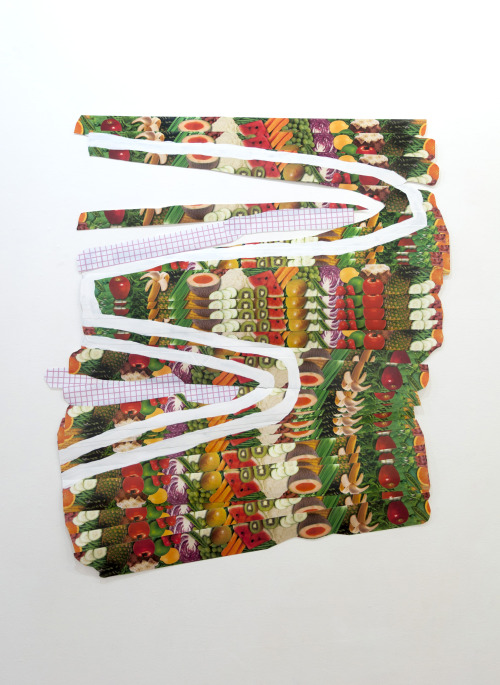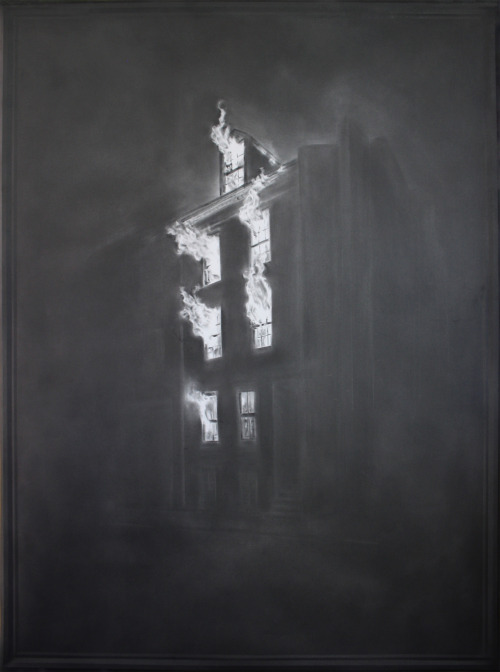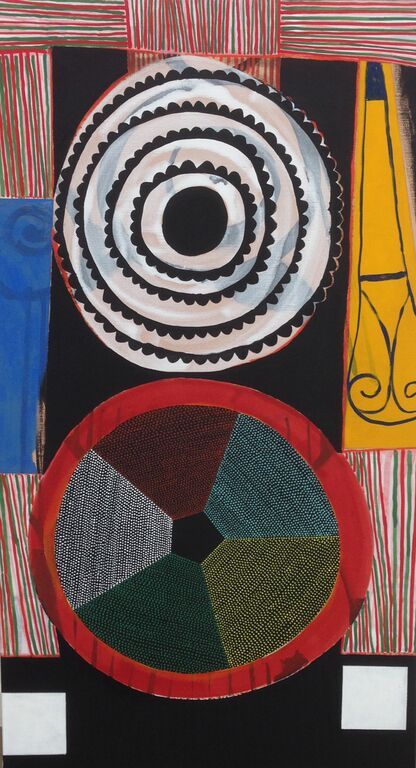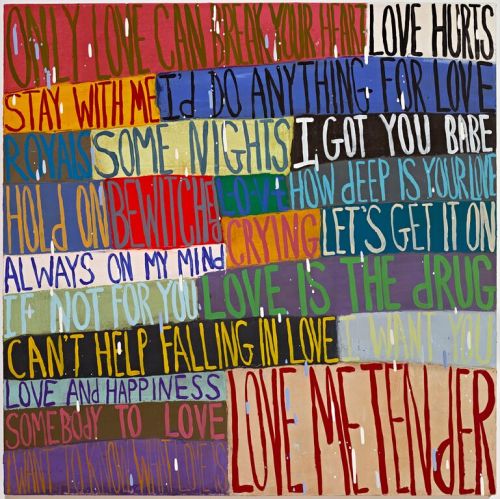
‘Conversations’ is a special focus at PULSE Miami Beach in the South Tent highlighting galleries presenting dual-artist exhibitions. Within these booths visual dialogues are explored and extended by the artists’ actual conversations, captured here.
Marnie Bettridge & Megan Stroech
ROCKELMANN&, Booth S-109
Marnie Bettridge: I generally have two different types of work, the first is work that starts with material exploration, and that i struggle over and am indecisive about (and that i never really feel comes to fruition). The second type is more rare and that is work that pops into my brain almost fully formed. I believe the first type informs the second somewhere in my subconscious. This body of work is of the second type.
I imagined them for a long time before i built them, and had a clear image of what i thought they would be when i started. Luckily factors such as materials, processes, and gravity inflict their will on my pieces too. Luckily because i feel if my imagination was so complete that the pieces came out how i initially wanted, I wouldn’t make them. It is the curiosity that drives me. Even with multiples, i long to see how they will be different or how they will look when installed together.
The works are large ceramic pieces that are completed when installed. They can be hung, draped, or placed on a surface. The viewer completes my work, and i always hope that they might occupy it mentally while looking at it.
Megan Stroech: The work I’m bringing to PULSE is a mix of printed digital collages and found object collage/painted works. The digital works are a recent addition to my studio practice, where I pull images from the internet as well as scan in physical materials, and then layer and alter them in Photoshop.
I’m still trying to reconcile how the digital works fit in or are in conversation with my other works, but I definitely think it’s fruitful territory for exploration into pulling in new content into the work. The larger collage works integrate landscape imagery and more recently, stock photos with found materials and paint.
The overall forms often oscillate between space and object and I’m interested in how these forms and materials can create a play between 2D and 3D, as well as painting and sculpture. I often inject small moments of discovery or humor in my work, as a way of inviting the viewer to reference one’s own everyday experience, whether it be a connection to a specific material or a piece’s overall form.

Marnie Bettridge: I have a background in architecture, which i believe shows through my work but i hope doesn’t overwhelm it. I studied for five years, worked at a new york firm for a handful more, and then went back to school to study architectural theory. I don’t have the personality of an architect– i love math and physics and details, but am not one for due diligence or over structuring. I never actually desired to become an architect architect, but i was really attracted to the studio atmosphere and learning process that architecture schools support. It goes, design something, draw it, talk about it, change it, defend it, repeat. And simultaneously, look, look, look.
Because the subject matter is so serious, the conversations had an intensity i did not find in art school. I think my use of scale and monochromatic materials betrays the amount of time i spent building museum board models in my youth. I came to making art by first longing to do so while a cad monkey in nyc. I desired the autonomy of a maker.
Then when my mother had a near death experience, and i spent months nurturing her rehabilitation, i had a long time to ponder what i really desired to make, and nothing functional seemed right. I found an MFA program close to home so i could still help my mother during the day and worked in the studio the program provided at night.
Megan Stroech: I’m originally from South Texas, I received my BFA in Studio Art at the University of Texas at Austin in 2008 where I focused on photographic lithography and monotype printmaking. I then went on to receive my MFA in Printmaking at Illinois State University in 2012. While I started the program producing more traditional prints, in my second year I began integrating more collage and painting into the work and my use of materials has evolved ever since. My family has always supported my creative pursuits, and it wasn’t until after receiving my BFA that I began to consider making art as a serious profession.
Marnie Bettridge: I am trying to create a beauty that a human can create, with my hands and my brain and my heart. I am also trying to express a frustration with society’s lack of appreciation for beauty. I know everyone loves a supermodel, but I mean that i believe a good solution to any problem will have a dignified, simple, poetic beauty to it, whether that is in the math or the balance or the scale. I see too much laziness of thought and shortsighted prioritization in very important places, and it drives me a little crazy.
I want the built environment to show thoughtfulness down to the simplest thing. My work also has something to do with an inner frustration about how quickly things are changing to support the amount of life on the planet. Or worse, for the sake of making money or greed. I feel powerless in this frustration of bigness and ugliness, and i find solace in making tiny beautiful things.
Megan Stroech: My process when creating an artwork is rather playful. I’m often on the floor of my studio arranging and rearranging materials, considering how these different found items relate to one another and what relationships can be conveyed to the viewer. I alter the materials by obscuring their shape additively through the use of paint, or by physically subtracting parts of the overall form in order to redirect their function. I’m interested in pulling together familiar items that the viewer can identify and has a previous relationship to, subverting conventional understanding of the material’s utility in order to spur new conversation between them.
Marnie Bettridge: I love beauty in material, and to me, beauty is linked to a healthy life cycle. Ceramics is one of my favorites, because the clay body is completely recyclable until you fire it, and then it is archival. I try not to fire anything i won’t use, but mistakes do happen. Even fired ceramics can be milled to powder and returned to a clay bodies. I also like to use materials that are overlooked or under-appreciated. Materials that are simple, of the earth. Materials that have less healthy life cycles i try to find second hand or get from my local refuse facility.
Megan Stroech: I carefully seek out the materials I use in my work, sourcing mostly from discount or hardware stores in Chicago. I am interested in the shift in context that happens when pulling these everyday objects into my work. When integrating these objects into the work, their placement often relies on color and formal relationships within each piece. I’m not sure that my relationship with the materials has changed, but I have allowed myself to pull in items I wouldn’t have used previously, often referencing the figure.
There is also an economy of material and mark-making in my recent work, I try to be very purposeful with each aspect of a piece, being mindful of elements seeming decorative or arbitrary in their placement. I think especially in work from the beginning of graduate school, areas became very repetitive and I find myself now being very conscious of that.
Marnie Bettridge: I have a really hard time generalizing about the art world. Was it Saltz who said they were actually seven art worlds? My studio is sort of in the middle of nowhere rural north florida, and i work very isolated. I love art, but i love one percent of it ultimately, and i suspect that is really how everyone is. So then it is super personal and about finding your world. That’s how i knew Rockelmann & was a good fit for me as a gallery– they had so many artists i really loved.
Megan Stroech: I’d say I’m still very much becoming acquainted with the art world and trying to find where I fit in it. I’m becoming pretty familiar with the art scene/community in Chicago and I feel that it exists in a very different space than those in NY/LA. I’m eager to see how my work is perceived to a much larger audience at PULSE.
Waytt Gallery & Simon Schubert
Foley Gallery, Booth S-203
Wyatt Gallery: Hi Simon I find it very exciting that we both create work that makes each other ask How are they making this?! I’ve wondered the same thing about your work many times! Mine are photographs of existing subway advertising walls where the ads have been found temporarily removed to reveal decades of layers of wear and tear created by unknown employees installing and removing advertisements.
I photograph the walls in vertical panels then re-stitch them together in Photoshop. I then remove the white subway tiles that border the alcove wall. That’s the only manipulating that I do. Otherwise it is a straight document of what I find. I then print them with a relatively new technique called UV Ink printed on to white DiBond. So the ink sits on top of the aluminum and gives an actual three-dimensional tactile surface. Blurring the line between photograph, painting, and sculpture.
What about you? How do you make those white pieces? I haven’t seen your new work? What’s that like?
Simon Schubert: Hi Wyatt Thank you for the info! Very interesting. That`s in some way how I thought you would do these works. It will be a pleasure to show with you at Pulse. The white works are made by folding the paper. The picture becomes visible through the light on the ridges of the folds and the shadows they cast. The exact way of working is a bit of a secret, but I use metal tools to get the folds into the paper and have a certain chronology of different steps in working on the pictures.
For me it is very important to reduce the material to just the paper and use the light to visualize the picture. The works that are at the gallery include light that is shining through windows in the pictures. So the picture itself becomes visible through light and the light is thematized in the pictures. I like that through this, time becomes a part of the work through the wandering light on the floor and walls in a series of pictures.
For the show I`ve done some researching on the places where Edgar Allan Poe used to live and tried to approach the work of Edgar Allan Poe from architecture. Some pictures show places where he used to live and some are fictional resembling places that could be part of his stories. Seen from a larger scale I work on the idea that all the white pictures, all the interiors, are part of a large building that is growing with every picture and the beholder wanders through it step by step.
I also started to do “black” works two years ago which are kind of a negative to the white ones, as they are covered almost completely with graphite (and for the white ones no pencil or color is used) and they mostly shown burning houses. The flames of the burning houses or other sources of light in the pictures are done through leaving them white on the paper and erasing on some points.
These works also deal with light in a different way as the white pieces as the light in the pictures begins to shine through the contrast. I studied in Dusseldorf at the Academy of Fine Arts and came to be making art through my interest in drawing, which started during childhood. During my studies I developed the technique of folding the paper. It took a few years to perfect the technique.
The first works where inspired by the texts of Samuel Beckett and I was looking for a way to link to Beckett and the way he was dealing with language, reducing it to a kind of essence. I was trying to find something similar for drawing – reducing the material and the image as far as possible. Over the last twelve years I`ve done different series of works, that are inspired by literature and film and art. So that ́s a little fast survey about my work of the last years.

Wyatt Gallery: You are a true surgeon in your skill of folding. What an amazing process with beautiful and subtle results. It will be interesting to see our work next to each other, both using paper as the subject. Maybe not the subject, but the source. For me the decaying walls that live beneath the glossy advertising campaigns also symbolizes each one of us as we often times portray a perfect outer shell yet beneath the surface we have wounds, wear and tear, and so much history.
This history, built from the combination of challenges and celebrations, is where our true beauty exists. Our inner beauty built from life’s ups and downs, similar to the remnants created by countless pastings of pretty advertisement posters and the tearing away and painting over it of it to install a new one.
Layers after layers built up over decades by unknown hands. I started noticing walls in NYC after returning from photographing Hurricane Katrina. In New Orleans, first the muddy water flooded the homes and left high waterlines and stains on the walls of people’s homes and personal spaces. Then the mold took over and left a new pattern, both created without intention and yet giving a portrait of the people of these environments without ever showing the people.
I have no control in the physical look of these walls. I just transport them to a new environment through photography. So it may seem as my work has changed with this new project SUBTEXT, but really it is just an extension of documenting the aftermath of places that have been torn apart unexpectedly, and seeing a haunting mysterious beauty in this destruction.
I normally photograph in the middle of the night when the subways are more empty. In order to get the entire wall in the shot, I take multiple exposures as verticals then later stitch them back together to recreate the whole wall. I never remove any ads that are up. I only photograph the walls where I happen to find the ads temporarily removed.
Simon Schubert: Thank you for the explanations. Sounds very interesting and I would love to accompany you when you go hunting for a good picture in the night. You probably know the work by Jacques Mahé de la Villeglé and Raymond Hains, who used to work with a Décollage technique removing part of the layers from advertising walls and creating pictures through this at some time in the fifties in the last century. I think your works are linked in a way to these artist’s works, creating a somewhat related picture, but approaching from a completely different point. It is great how art history is present in your photos but you create something entire new. I love that, as contemporary art is surely based on art history! Love to show with you!
FEATURED EVENT
Saturday, July 22 2023
Founded in 2005,PULSE is as an established part of the annual art calendar with editions in New York and Miami Beach.
more »

